|
OK [Cambodian Chess]
Ok, or Cambodian Chess, is a variant of the
popular game of chess introduced in Southern Asia many centuries ago. Ok is
similar to the form of chess played in most western countries in a number of
ways. Like western chess, the object of Ok is to capture the opponent's King. If
it becomes impossible to capture either player's King, then the game is declared
a draw. Only one piece may occupy a square at any given time, and only
Horses/Knights have the capacity to leap over other pieces. In Ok, there are
many more short-range pieces than in western chess, making capture of a King in
early or middle game extremely difficult. Hence, endgame is a key component of
Ok. When all of the opponent's pieces have been captured, special rules requiring the
capture of the opposing King within a prescribed number of moves come into play
(discussed in more detail below).
Board Set Up
Unlike western chess, the queen is always to
the right of the king regardless of whether the pieces are white or black.
Hence, either player may begin the game,
whether playing white or black. Only
one piece may be moved at each turn.
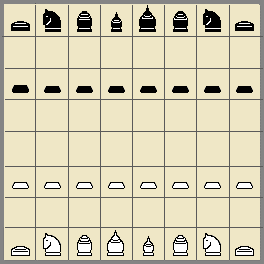
Note: Ok boards are usually monotone, with spaces separated by
grooves rather than a checker pattern. Unlike western chess which has pieces
that move long distances diagonally (namely bishops and queens), Ok pieces that
move diagonally only do so one space at a time (more below), therefore negating
need for a checkered pattern. Board coloration has no relevance to the game,
however, and a checker patterned chess board may be utilized in lieu of an Ok
board to play the game.
Piece Movement
Pieces have been listed in order of
importance/power.
In parentheses are names of their western counterpart.
KING
 The King may move 1 space in any direction.
When directly attacking an opposing King with a Boat or Horse, the player must say
"ok" to announce the attack. If attacking the King with a Post, Queen or Fish, the
attacker says "ruk" instead of "ok". In
the case of discovered check (attack on a King caused by removing a piece
to unmask the line of attack by a Boat), the attacking player says "pi".
Special Rule: On his first move the
King may transport himself an extended distance along the second row
of his side of the board (as shown by the dots in the illustration at
right). He may
not use the special extended movement,
however, in response to direct attack from an opposing piece.
|
BOAT (rook)

The Boat is the most powerful piece in Ok
as it is the only true long range weapon in this game.
It may move any number of spaces vertically or horizontally along open
space. It may not leap over spaces occupied by other pieces.

|
HORSE (knight)
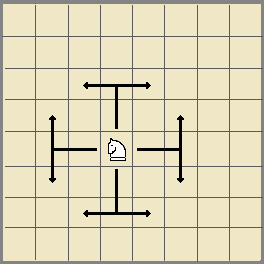
The Horse is the only piece that may leap
over spaces occupied by other pieces. It moves in an L pattern as
diagramed above and may
move in any direction as long as it can land on an unoccupied space. |
BORDER POST (bishop)
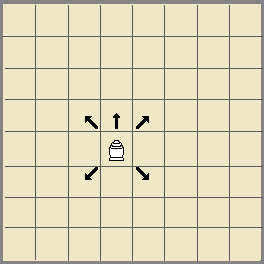
The Post is considered less powerful
than the horse in early and middle game, but often becomes a more useful
piece in endgame play. It may move in
any of the three spaces in front or diagonal to it when advancing but only
to the two diagonal spaces behind it when retreating. |
QUEEN
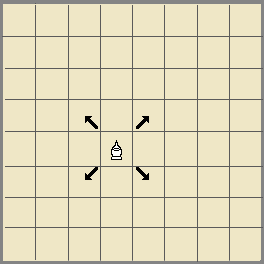
Unlike western chess, the Queen is the
least powerful of the major pieces in Ok. She may move only diagonally and
one space at a time.
Special Rule: On her first move, the Queen has the option of
advancing forward two spaces if the Fish in front of her
has advanced and the space is unoccupied (as shown by
the dot in the illustration below). 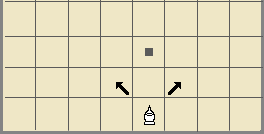 |
FISH (pawn)
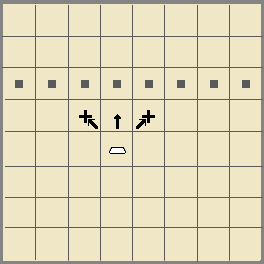
Fish swim forward one space at a time,
but attack opposing pieces diagonally. Upon reaching the 6th row of the
board (as shown by the dots), they are automatically promoted and
henceforth function like Queens. Note:
Fish pieces in Ok sets are designed to be flipped over upon reaching the 6th row
to distinguish between promoted and unpromoted Fish. In using a western chess set, bottle caps
are a suitable substitute for these special Ok pieces and should be used in lieu of pawns.
Place the bottle caps crown side down to function as unpromoted Fish and
flip them over so the crown side is up upon reaching the 6th row of the
board. In this way, promoted and unpromoted Fish are easily
discernable. |
Special Endgame Rules In
the event that one player has only a King remaining on the board, special rules come into effect giving the opposing player an allotted number of
moves with which to capture that King. Should the player with the extra pieces fail to capture the
opponent's King within the allotted movements, then the game is considered a draw.
Remaining Unpromoted Fish
The following rule applies in cases where the player with the extra pieces has Fish remaining on the board that have not been
promoted, regardless of what other pieces that player may still possess:
- The players add the number of pieces left on the board and
subtract it from 64, and these are the number of moves the player with the extra
pieces has
to capture the opposing King. For example, if there are still 5 pieces total left on
the board (including the Kings), then the player with the extra pieces must
capture the opposing King in 59
moves or the game is considered a draw.
No Remaining Unpromoted Fish
In cases where the player with the extra pieces
has no unpromoted Fish remaining on the board, the number of moves in which that
player is required to capture the opposing King is determined as follows:
- If the player has 2 Boats,
subtract the number of pieces left on the board from 8.
- If the player has
1
Boat, subtract the number of pieces left on the board from 16.
- If the player has
2
Posts, subtract the number of pieces left on the board from 22.
- If the player has 2 Horses,
subtract the number of pieces left on the board from 32.
- If the player has
1
Post, subtract the number of pieces left on the board from 44.
- If the player has 1 Horse,
subtract the number of pieces left on the board from 64.
- If the player has
any combination of Queen and promoted Fish, subtract the number of pieces left on the board from
64.
The capture of a piece by a fleeing King may
trigger a new count. For example, if the player with the extra pieces has
2 Posts and 2 Horses remaining, the number of moves allotted to capture the opposing King is
16 (22 subtracted by the 6 pieces left on the board). However, if one of the
Posts is later captured by the opposing King, then the count begins anew and the number of moves
allotted becomes 27 (32 subtracted by the 5 pieces remaining on the board).
As in western chess, the rule of tie by stalemate also applies (i.e., when a King is put into a
position in which the player cannot move without putting that King in line of a
direct attack).
Alternate Version of Play A
variation of Ok popular in olden times is known as Ka Ok ("defend
against being placed in check"). In this style of play, the first player to
place the opposing King in check wins the game.
Play Ok Online
Play Ok against another person or against the computer at ouk.sourceforge.net
Special thanks to Mr. Yanna Doeur
for his input and insight.
BACK TO TOP
|